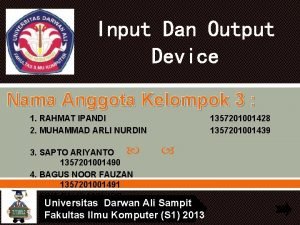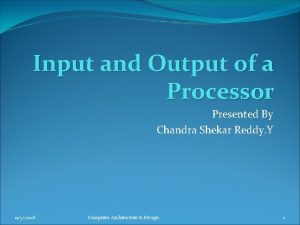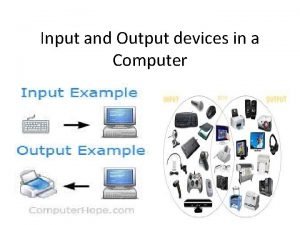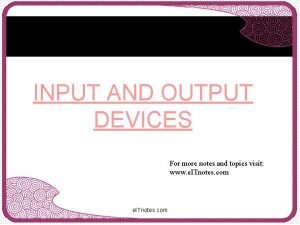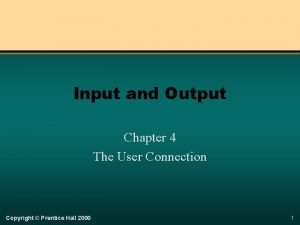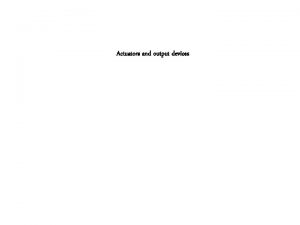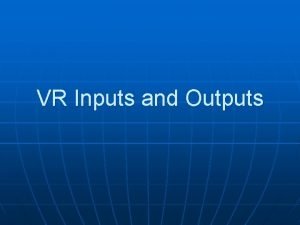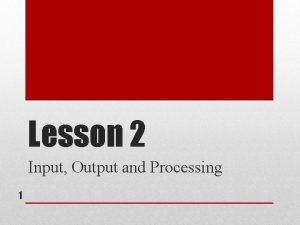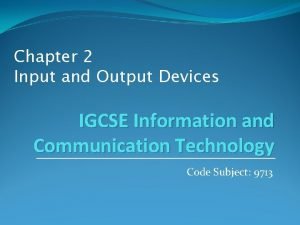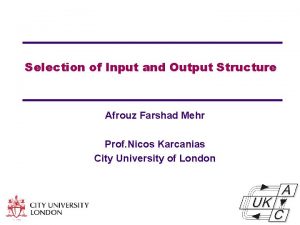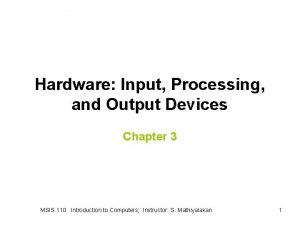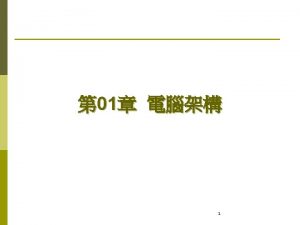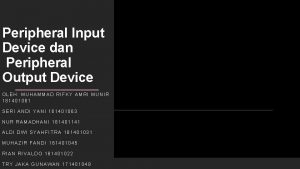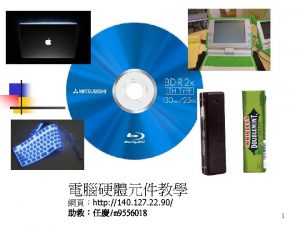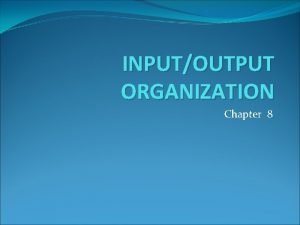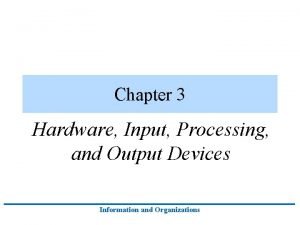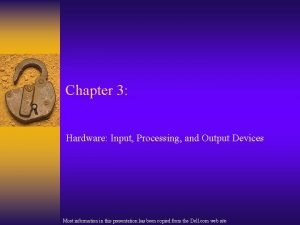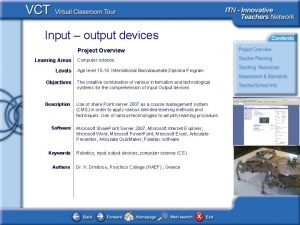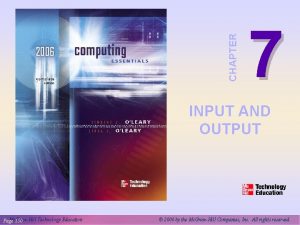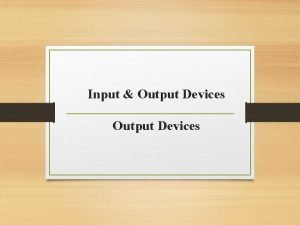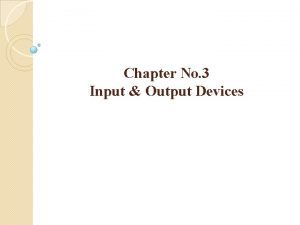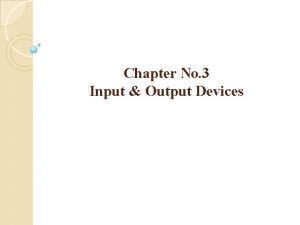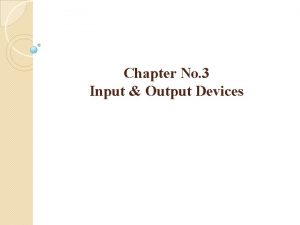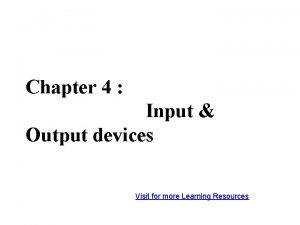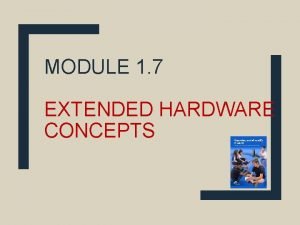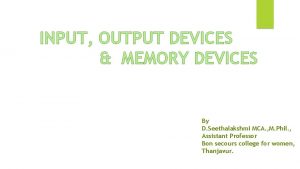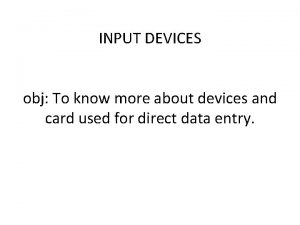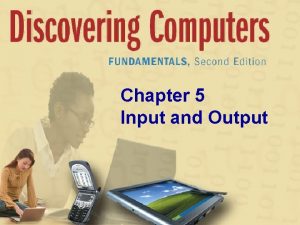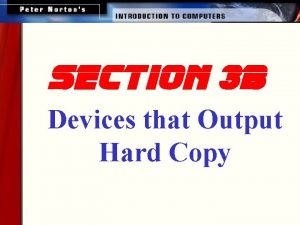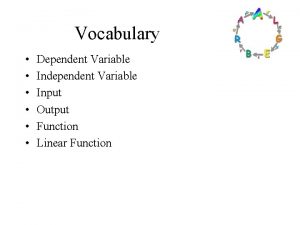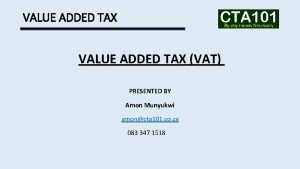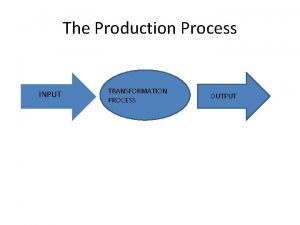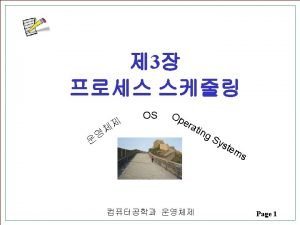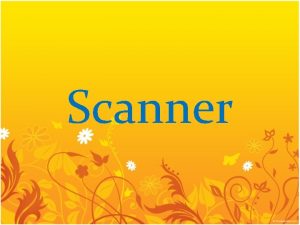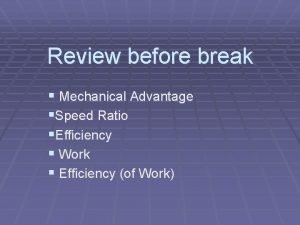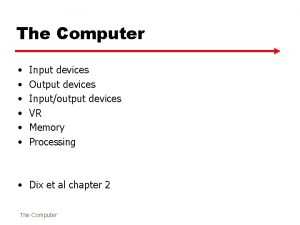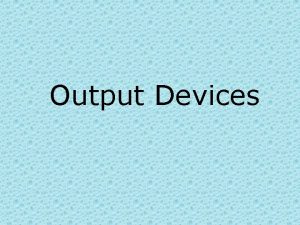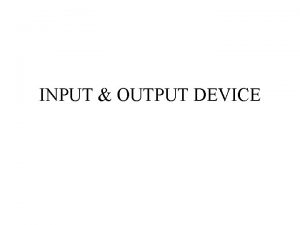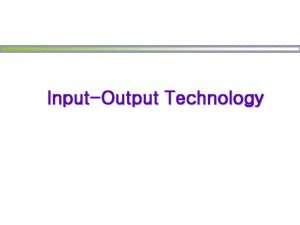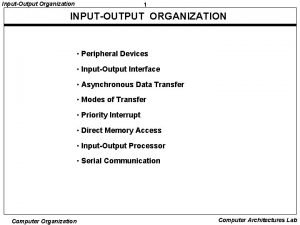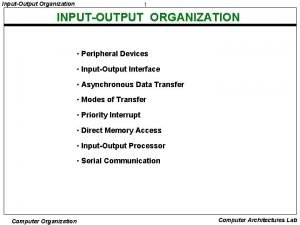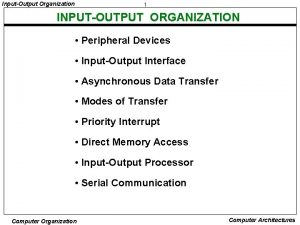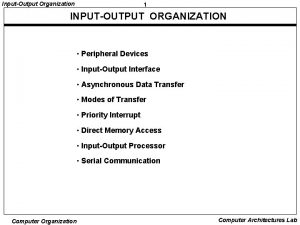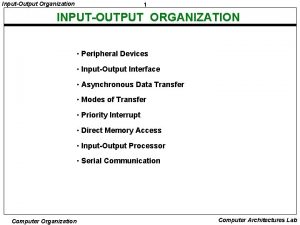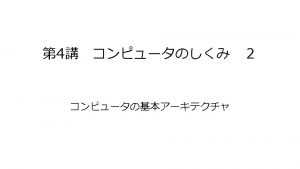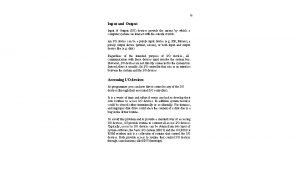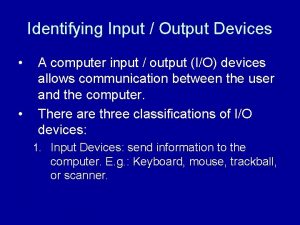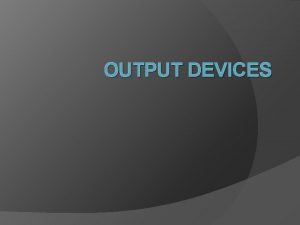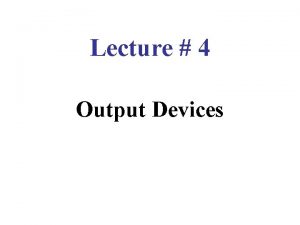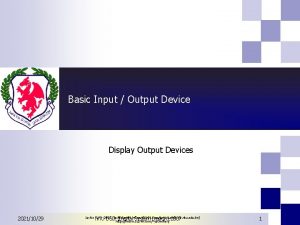Device Management 5 InputOutput Devices Output Device Input



















































- Slides: 51

Device Management 5

Input/Output Devices Output Device Input Device Processor

The Device Driver Interface … write(…); … Device Interface Terminal Driver Printer Driver Disk Driver Terminal Controller Printer Controller Disk Controller

Device Management Organization Application Process System Interface File Manager Device-Independent Device-Dependent Hardware Interface Command Status Device Controller Data

System Call Interface • Functions available to application programs • Abstract all devices (and files) to a few interfaces • Make interfaces as similar as possible – Block vs character – Sequential vs direct access • Device driver implements functions (one entry point per API function)

Example: BSD UNIX Driver open close ioctl read write strategy select stop Prepare dev for operation No longer using the device Character dev specific info Character dev input op Character dev output op Block dev input/output ops Character dev check for data Discontinue a stream output op

Overlapping the Operation of a Device and the CPU. . . read(dev_I, “%d”, x); y = f(x). . . start. Read(dev_I, “%d”, x); . . . While(still. Reading()) ; y = f(x). . . Data on device Variable x Register Memory CPU Device dev_I

Gantt Chart • A Gantt chart is a graphical representation of the duration of tasks against the progression of time. http: //www. ganttchart. com/

Gantt Chart • Gantt charts are useful tools for planning and scheduling projects. • Gantt charts allow you to assess how long a project should take. • Gantt charts lay out the order in which tasks need to be carried out. • Gantt charts help manage the dependencies between tasks. • Gantt charts determine the resources needed.

Gantt Chart • Gantt charts are useful tools when a project is under way. • Gantt charts monitor progress. • You can immediately see what should have been achieved at a point in time. • Gantt charts allow you to see how remedial action may bring the project back on course.

• Henry Laurence Gantt (1861 -1919) was a mechanical engineer, management consultant and industry advisor. • Henry Laurence Gantt developed Gantt charts in the second decade of the 20 th century. • Gantt charts were used as a visual tool to show scheduled and actual progress of projects. • Accepted as a commonplace project management tool today, it was an innovation of world-wide importance in the 1920 s. • Gantt charts were used on large construction projects like the Hoover Dam started in 1931 and the interstate highway network started in 1956.

• Henry Gantts contribution to the management process is honored today through the Henry Laurence Gantt Medal. • The award established in 1929 is given for distinguished achievement in management and for service to the community.

Overlapping CPU-Controller Operations in a Process App I/O Ctlr t 1 t 2 t 3 t 4 t 5 t 6 t 7 t 8 t 9

Overlapping Processing and I/O App 1 App 2 I/O Ctlr t 1 t 2 t 3 t 4

I/O strategies • 1. Direct I/O with Polling. • 2. DMA I/O with Polling. • 3. Direct I/O with Interrupt. • 4. DMA I/O with Interrupt.

Polling I/O Read Operation read(device, …); 1 System Interface Data read function 5 write function 2 3 4 Hardware Interface Command Status Device Controller Data

Direct I/O with Polling (IN) • 1. The application process requires a read operation. • 2. The device driver queries the status register to determine if the device is idle, if the device is busy, the driver waits for it to be idle. • 3. The driver stores an input command into the controller’s command register, thereby, starting the device. • 4. The driver repeatedly reads the status register while waiting for the device to complete its operation. • 5. The driver copies the contents of the controller’s data register(s) into process’s space.

Direct I/O with Polling (OUT) • 1. Process requests an output operation. • 2. Driver status register, busy? Wait. • 3. Driver copies data from user space memory controller’s data registers. • 4. The driver stores an output command into the command register, thereby starting the device. • 5. The driver repeatedly reads the status register while waiting for the device to complete the operation.

Interrupt-driven I/O Operation read(device, …); 1 9 8 b Data System Interface Device Status Table read driver 2 4 7 Device Handler write driver 6 3 Interrupt Handler 5 Hardware Interface Command Status Device Controller Data 8 a

Interrupt Driven I/O Operation • 1. Process requests a read operation • 2. Top half of the driver queries the status register, idle? -> Yes! -> Wait! • 3. If no longer busy, the driver stores command into the controller’s command register and thereby starting the device for read operation. • 4. When read driver completes its work, information regarding the op -> device status table.

• Device Status Table contains an entry for each device in the system. • 5. Eventually, the driver completes the operation and interrupt the CPU and cause the interrupt handler to run. • 6. The interrupt handler determines which device caused the interrupt. It then branches to the device handler for that device. • 7. The device handler retrieves the pending I/O status information from the device status table. • 8. The device handler copies the contents of the controller’s data registers into the user process’s space (memory). • 9. The device handler-behaving as the bottom half of the device driver invoked by the application processthus returns control to the application process.

Device Independent Function Call Trap Table funci(…) dev_func_i(dev. ID, …) { // Processing common to all devices … switch(dev. ID) { case dev 0: dev 0_func_i(…); break; case dev 1: dev 1_func_i(…); break; … case dev. M: dev. M_func_i(…); break; }; // Processing common to all devices … }

Driver-Kernel Interface • Drivers are distinct from main part of kernel • Kernel makes calls on specific functions, drivers implement them • Drivers use kernel functions for: – Device allocation – Resource (e. g. , memory) allocation – Scheduling – etc. (varies from OS to OS)

Reconfigurable Device Drivers System call interface open(){…} read(){…} Entry Points for Device j etc. Driver for Device j Other Kernel services

Handling Interrupts Device driver J int read(…) { // Prepare for I/O save_state(J); out dev# // Done (no return) } Device status table J Device interrupt handler J void dev_handler(…) { get_state(J); //Cleanup after op signal(dev[j]); return_from_sys_call(); } Interrupt Handler Device Controller

Handling Interrupts(2) Device driver J Device interrupt handler J int read(…) { … out dev# // Return after interrupt wait(dev[J}); return_from_sys_call(); } void dev_handler(…) { //Cleanup after op signal(dev[j]); } Interrupt Handler Device Controller

The Pure Cycle Water Company Customer Office Water Company Returning the Empties Water Producer Water Consumers Delivering Water

Hardware Buffering Process Controller Data A Device Unbuffered Process B Process reads bi-1 Controller reads bi A B Device Process reads bi Controller reads bi+1

Driver Double Buffering in the Driver Process A A B Hardware Controller A B Device B Controller A B Device

Circular Buffering Buffer j Buffer i To data consumer From data producer

A Generic Communications Device Bus Generic Controller Communications Controller Local Device Cabling connecting the controller to the device Device • Printer • Modem • Network

Rotating Media Sec tor Track (Cylinder) Cylinder (set of tracks) (a) Multi-surface Disk (b) Disk Surface (b) Cylinders

Storage Device Driver API Driver • Get disk description • Set SCSI parms • read/write ops • Interrupt hander SCSI API • commands • bits per byte • etc. Controller (SCSI) Magnetic Disk

Compute vs I/O Bound Compute-bound Time I/O-bound

Disk Optimizations • Transfer Time: Time to copy bits from disk surface to memory • Disk latency time: Rotational delay waiting for proper sector to rotate under R/W head • Disk seek time: Delay while R/W head moves to the destination track/cylinder • Access Time = seek + latency + transfer

Optimizing Seek Time • Multiprogramming on I/O-bound programs => set of processes waiting for disk • Seek time dominates access time => minimize seek time across the set • Tracks 0: 99; Head at track 75, requests for 23, 87, 36, 93, 66 • FCFS: 52+ 64 + 51 + 57 + 27 = 251 steps

Optimizing Seek Time (cont) • Requests = 23, 87, 36, 93, 66 • SSTF: (75), 66, 87, 93, 36, 23 – 11 + 21 + 6 + 57 + 13 = 107 steps • Scan: (75), 87, 93, 99, 66, 36, 23 – 12 + 6 + 33 + 30 + 13 = 100 steps • Look: (75), 87, 93, 66, 36, 23 – 12 + 6 + 27 + 30 + 13 = 87 steps

Optimizing Seek Time (cont) • Requests = 23, 87, 36, 93, 66 • Circular Scan: (75), 87, 93, 99, 23, 36, 66 – 12 + 6 + home + 23 + 13 + 30 = 90 + home • Circular Look: (75), 87, 93, 23, 36, 66 – 12 + 6 + home + 23 + 13 + 30 = 84 + home

Serial Port CPU Memory Serial Device • Printer • Terminal • Modem • Mouse • etc.

UART • universal • asynchronous • receiver • transmitter


Serial Port Device Driver API Device Driver Software on the CPU • Set UART parms • read/write ops • Interrupt hander UART API • parity • bits per byte • etc. Bus Interface Serial Device (UART) RS-232 Interface • 9 -pin connector • 4 -wires • bit transmit/receive • . . .

Adding a Modem CPU Memory Serial Device Modem • Dialing & connecting • Convert analog voice to/from digital • Convert bytes to/from bit streams • Transmit/receive protocol Phone Switched Telephone Network

Serial Communication Device Driver • Set UART parms • read/write ops • Interrupt hander Driver-Modem Protocol • Dialing & connecting • Convert analog voice to/from digital • Convert bytes to/from bit streams • Transmit/receive protocol Serial Device RS-232 Modem

Exploiting the Phone Network Logical Communication CPU Memory CPU Comm Device Modem Phone Switched Telephone Network Memory

Data Networks • Technology focus includes protocols and software (more on this later … Chapter 15 and beyond. . . ) Logical Communication CPU Memory Network Device Data Network CPU Memory

The USB Process • When the host powers up, it queries all of the devices connected to the bus and assigns each one an address. • This process is called enumeration -devices are also enumerated when they connect to the bus. • The host also finds out from each device what type of data transfer it wishes to perform:

• Interrupt - A device like a mouse or a keyboard, which will be sending very little data, would choose the interrupt mode. • Bulk - A device like a printer, which receives data in one big packet, uses the bulk transfer mode. A block of data is sent to the printer (in 64 -byte chunks) and verified to make sure it is correct. • Isochronous - A streaming device (such as speakers) uses the isochronous mode. Data streams between the device and the host in real-time, and there is no error correction.

MS Disk Description-Boot Sector

NT Driver Organization

NT Device Drivers • API model is the same as for a file • Extend device management by adding modules to the stream • Device driver is invoked via an Interrupt Request Packet (IRP) – IRP can come from another stream module – IRP can come from the OS – Driver must respond to minimum set of IRPs • See Part I of notes
 Inputoutput devices
Inputoutput devices Ram input or output device
Ram input or output device Output devices
Output devices Input device dan output device
Input device dan output device Virtual reality input and output devices
Virtual reality input and output devices Conclusion for input and output devices of computer
Conclusion for input and output devices of computer Advantage of input device
Advantage of input device Conclusion for input and output devices of computer
Conclusion for input and output devices of computer Output devices purpose
Output devices purpose Advantages of input devices
Advantages of input devices Notes on output devices
Notes on output devices Input and output devices conclusion
Input and output devices conclusion Is actuator input or output
Is actuator input or output Vr input and output devices
Vr input and output devices Input and output devices wiring for plc
Input and output devices wiring for plc Specialized input device
Specialized input device Computer input devices drawing
Computer input devices drawing Touch screen is a input or output device
Touch screen is a input or output device Conclusion of input and output devices
Conclusion of input and output devices Input devices
Input devices Input pp
Input pp Perangkat input device peripheral
Perangkat input device peripheral Memory unit
Memory unit Accessing input output devices
Accessing input output devices Hardware input processing and output devices
Hardware input processing and output devices Input process output storage
Input process output storage Input and output devices project
Input and output devices project Combination input and output devices
Combination input and output devices Damls
Damls Is laser printer an input or output device
Is laser printer an input or output device Plotter is input or output
Plotter is input or output Is a inkjet printer an input or output device
Is a inkjet printer an input or output device Plotters input or output
Plotters input or output Digitizer is an input device
Digitizer is an input device Flatbed scanner input or output
Flatbed scanner input or output Keyboard input or output
Keyboard input or output Extended hardware concepts
Extended hardware concepts Output device
Output device Is a magnetic stripe reader an input or output device
Is a magnetic stripe reader an input or output device Fax machine is input or output device
Fax machine is input or output device Is a dot matrix printer an input or output device
Is a dot matrix printer an input or output device Independent variable is x or y
Independent variable is x or y Vat input
Vat input Vat input meaning
Vat input meaning Vat input meaning
Vat input meaning Input-transformation-output model examples
Input-transformation-output model examples Cpu burst io burst
Cpu burst io burst What is input design in system analysis and design
What is input design in system analysis and design Septum pellucidum
Septum pellucidum Scanner is an input device
Scanner is an input device The ratio of input distance to output distance
The ratio of input distance to output distance How to make a scope and limitation of the study
How to make a scope and limitation of the study



